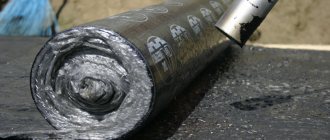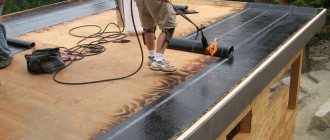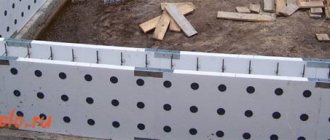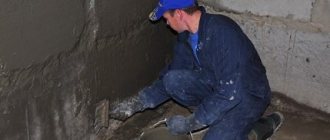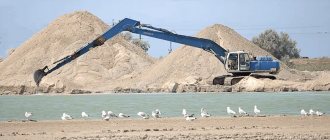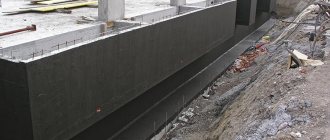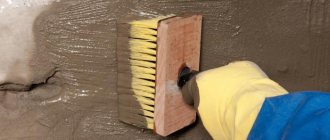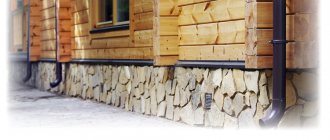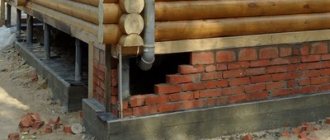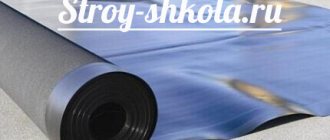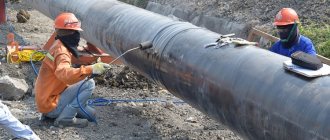Protection of foundations from corrosion, freezing and destruction.
Despite the fact that modern concretes are highly durable, they remain susceptible to various types of corrosion. In most cases, this is exposure to aggressive chemical environments and groundwater contaminated with acids and alkalis.
How to protect a concrete foundation from destruction.
Also, do not forget about acid rain, which often falls in industrial areas. It is also slowly degraded by exposure to sulfates and phosphates, chlorides and other strong electrolytes.
If the foundation is built above the freezing zone, then it is also subject to strong pressure from frozen soil, uneven displacement of layers occurs and the base is deformed.
Foundation waterproofing technology
Preparatory work
It’s not enough to know how to waterproof a foundation. Quality preparation is needed. All surface defects should be identified. Loose concrete and areas with exposed crushed stone and/or reinforcement must be dismantled and plastered with Skrepa M500 repair mixture. The reinforcement is pre-cleaned and primed with an anti-corrosion solution. Defects are not always noticeable; they can be hidden by cement laitance. This milk is removed, for example, with the Himfreza composition.
There are a lot of seams in a concrete foundation, especially if it is a block structure. These are the most vulnerable places. The joints are pre-deepened by 20-25 millimeters, cleaned and, after washing, moisturized well. Then we recommend sealing these places with Penecrit.
Cracks and crevices are sealed, again, with Penecrit. The moistened surface is treated with Penetron in two layers. Possible leaks in concrete are eliminated using Waterplug or Peneplug mixtures. Leaking areas are widened by at least 25 mm in width and deepened by 50 mm. It is recommended to expand in depth in the form of a dovetail. In the case of abundant hydrofiltration with a large water influx, it is necessary to use injection resins such as PenePurFom. But this is done with the help of special devices and equipment.
Very often, FBS foundations contain brick inserts. What waterproofing should I choose for the foundation in this case? In this situation, it is worth paying attention again to Skrepa M500. It is used to plaster the brick over a metal mesh, simultaneously achieving a significant increase in strength and waterproofing effect. We must not forget about Penecrit, which is used to seal the joints, and in this case along the border of the M500 Scraper and the FBs themselves.
Final treatment with Penetron
At this point, the preparation is complete and you can proceed to the final stage. After the mixtures used have set, the surface to be treated must be cleaned and moistened very well. Finally, prepare the Penetron mixture and apply the solution in two layers - with a break of 4-6 hours, or as soon as the first layer dries. After completion of the work, the foundation is moistened for three days at intervals of several hours. At this stage, we can say that you already understand how to properly waterproof a foundation.
The ready-mixed composition must be used within half an hour, so prepare the amount that can be applied during this time, otherwise the composition will turn into stone!
Types of concrete corrosion.
Anti-corrosion protection of the foundation.
Corrosion processes taking place in concrete.
- First view. Destruction of concrete occurs due to exposure to various aggressive media contained in groundwater. Due to corrosion of the upper surface of the foundation, slow dissolution of the cement mortar occurs. Also, groundwater may contain bicarbonate, which is soluble in water, but is highly alkaline and has a negative effect on concrete sand. If the influence of groundwater occurs in winter near the border of the freezing zone, then there is practically no chance of saving the foundation.
- With another type of corrosion, chemical metabolic reactions occur, in which the foundation filling slowly dissolves, as well as the destruction of the reinforcing layer. Therefore, it is strictly forbidden to add machine oil or various saturated fats to them when pouring concrete using concrete mixers.
- The most dangerous is the third type of corrosion. It occurs in the process of replacing concrete salts with metabolic products, for example, sea water. In such cases, mechanical expansion of concrete pores occurs, destruction of the load-bearing layers and filling with hydrates. In most cases, this is a classic stage of destruction due to sulfates and carbonates, and the rate of concrete corrosion depends on its porosity, grade and permeability.
If we take into account all possible types of concrete deformation, then it immediately becomes clear that the key medium due to which the destruction of the foundation occurs is groundwater and rainwater.
Therefore, the main way to protect concrete from exposure to aggressive environments is high-quality waterproofing.
It is also necessary to initially build a foundation with a sole below the boundary freezing zone.
How to do it yourself?
Since waterproofing does not require qualifications, you can do everything yourself. How long after pouring the foundation should waterproofing be done? You can start processing no earlier than in a month.
Approximately 2 weeks after pouring, the formwork is removed and another 2 weeks are needed to increase the characteristics.
It is not recommended to delay the treatment of the foundation with insulation too much. In particular, it cannot be postponed until the next season, since at this time, without additional protection, groundwater and precipitation will negatively affect the structure.
The main stages of work on applying waterproofing:
Cleaning the foundation from dust and dirt.- Repairing chips and smoothing corners.
- Checking the moisture level of concrete. Waterproofing is installed at a humidity of no more than 4%.
- Applying a primer to the surface, which is an adhesive base (if necessary).
- Laying/application of waterproofing, taking into account the rules for working with a specific material.
- Strengthening corners to prevent the formation of tears during shrinkage before smoothing the waterproofing material (for rolled materials).
- Fastening the waterproofing.
How to waterproof a foundation with your own hands, read in this publication.
Features for an already built, old house
You can make waterproofing even in a house that was commissioned a long time ago. For this purpose, external finishing with coating, roll or penetrating materials is used .
For repairs, it is necessary to dismantle the blind area and decorative cladding of the foundation, and also dig the foundation approximately 1 meter deep along the entire perimeter.
After this, you can begin work. The most reliable is penetrating insulation. The simplest one is roll.
Read about waterproofing between the plinth and the foundation here, between the masonry and the foundation - here,
Nuances for buildings made of different materials
In addition to external insulation, in a finished house it is recommended to make horizontal insulation between the masonry and the foundation or between the plinth and the foundation. Cut-off insulation prevents moisture from penetrating from the foundation to the walls of the structure .
The wooden frame can simply be lifted. To do this, the walls are stitched with boards and fixed with screws or nails. Jacks are installed at each corner and the structure is lifted quite easily. Waterproofing is carried out using coating or roll materials. The same applies to frame houses.
With a brick or block house the situation is more complicated , since the junction of the walls and the foundation is not so obvious and is securely fixed with cement. Cut-off waterproofing should be carried out by impregnating the masonry walls with silicone water repellents.
In addition, to insulate the masonry, the seams are unstitched and caulked with a waterproofing mixture. Then it is necessary to plaster the surface with a waterproofing mixture over the reinforcing mesh.
Read the technology for installing waterproofing for a log frame on a foundation here.
Methods of neutralizing corrosion of the metal of the reinforcing layer.
Foundation protection is corrosive.
Factors contributing to corrosion of concrete and reinforced concrete, its types and prediction.
- When constructing the base, all reinforcing bars are completely filled with concrete, and any possible contact with the environment is eliminated;
- Adhere to the rules for laying reinforcement, because it must be located at a distance of at least 2.5 cm from the surface;
- When pouring concrete mortar, eliminate air pockets and use only fine gravel;
- If the reinforcement is also installed in the soil freezing zone, then special compounds and minerals are added to the concrete, which block the process of metal corrosion. They also coat the metal itself with a thick layer of oxide and create an additional barrier of protection.
It is also recommended to carefully familiarize yourself with the composition of cement, especially its quantitative components. As a rule, it is prohibited to allow the concentration of calcium chloride to exceed 2% of the total mass of cement.
Although it is an important mineral component, it reacts with carbon dioxide to form chalk. And over time, under the influence of even weak acids, it dissolves. Accordingly, destruction of the reinforcement is inevitable, because liquid calcium chloride is very active.
If the concentration of calcium chloride is allowed to exceed, then only highly specialized specialists can stop the destruction of the foundation, and the financial costs will be enormous.
Secondary protection of the foundation from corrosive factors.
Foundation protection is corrosive.
The simplest way to protect concrete structures from corrosion is painting.
Such protection involves applying special protective paints or varnishes to the outer surface of the base.
As a rule, impregnation is done here to the maximum possible depth, but there are many factors that influence stopping the process of concrete deformation. First of all, this:
- Anti-corrosion coating does not always guarantee stopping the process;
- Without special inhibitors in the concrete, the external coating will not always be effective enough;
- The time factor plays an important role, because internal corrosion of metal cannot be stopped by coatings;
- The effectiveness of impregnation depends on the composition and consistency, so it is recommended to use a liquid mixture for maximum penetration into the material. On the other hand, the consumption of liquid mixtures is huge, and viscous compounds are easy to apply, but penetration is minimal.
Features of protecting the base of the foundation from corrosion in the freezing zone.
Protection of the foundation of the house is corrosive.
Typical scheme for protecting the foundation from freezing.
Considering that in the freezing zone the bud is especially susceptible to harmful effects, then you need to choose the right protective substances and compositions.
First of all, here you need to do external impregnation with frost-resistant anti-corrosion compounds. They are produced on the basis of minerals and epoxy resins.
The depth of concrete impregnation at the freezing depth must be at least 10 cm, and the reinforcement must be located at a distance of at least 5 cm from the outer surface of the foundation.
They also practice coating reinforcing bars with polymer resins, and mineral ingredients are added to the concrete that can withstand the effects of low-temperature groundwater.
Principles of protection.
Foundation protection is corrosive.
Applying mastic to a concrete base.
As a rule, the most severe destruction of concrete occurs through the influence of three key factors at once: moisture, electrolytes and frost. Therefore, concrete in the soil freezing zone is subject to severe destruction; on such horizons it is necessary to use frost-resistant and moisture-resistant concrete mixtures.
Additional anti-corrosion treatment of the sole is also carried out, subject to its availability. Columnar structures are not treated with anti-corrosion compounds; here the problem can only be solved by choosing the right concrete and having a high-quality waterproofing layer.
Thus, concrete in this zone is protected by two methods at once: internal structural changes in the characteristics of concrete and external treatment. Only a combination of these methods can save the foundation from destruction.
In specialized construction stores you can always buy organic and mineral additives that increase the strength and durability of concrete before exposure to aggressive environments.
It is recommended to carry out secondary treatment with expensive hydrophobic compounds, as well as polymer liquid mixtures. The main purpose of such protection is to fill the air formations and pores of concrete with compounds that are resistant to external aggressive environments.
Also, in the process of applying the compositions, a durable protective film is formed on the concrete surface itself. The coating is used at the stage of laying the foundation or during its repair.
The best way to waterproof a foundation - Penetron materials
Understanding the essence of impregnations and related materials will tell you how to waterproof a foundation according to the rules.
- Penetron is the main material of the complex. It is certainly present as one of the components. Advantages:
- penetrates to a depth of at least 30-40 cm; over time, the depth reaches up to 90 cm;
easy to use - applied with a brush;
- increases frost resistance at least twice;
- increases the strength of concrete up to 15%;
- protects reinforcement from corrosion;
- resistant to aggressive environments;
- characterized by self-healing of microcracks;
- vapor permeable;
- a huge range of uses (up to nuclear power plants, thermal power plants, etc.);
- environmentally friendly, allowed for contact with drinking water.
- Penecrit: the composition is used to seal joints/seams/junctions/cracks in combination with Penetron. It is characterized by the absence of shrinkage, high strength and water resistance, good adhesion to concrete, stone, brick, and metal.
- Peneplug and Waterplug - Hydraulic seals that quickly eliminate pressure leaks in structures made of concrete, stone and brick. Fast setting time (depending on temperature and material). Characterized by the ability to expand. Used in conjunction with the two previous types.
- Penetron Admix is an additive that is used at the concrete preparation stage. Increases the performance of a concrete foundation in terms of strength, water resistance and frost resistance. Can be used in combination with Penebar or Penecrit (after the concrete with the additive has set).
- Penebar is a waterproofing strand designed to seal construction and working seams and utility passages. Expanding several times upon contact with water, Penebar creates pressure and becomes an excellent water barrier.
Still wondering what kind of waterproofing to choose for your foundation? Penetron is characterized by the highest maintainability. Problems are resolved quickly and locally.
These are not all the materials of the complex, but those described are the main ones. Read on to learn how to properly waterproof a foundation using them.
What is internal foundation protection?
Foundation protection is corrosive.
Various additives to concrete mix.
It is done at the stage of laying the future foundation. As a rule, the essence of protection is the correct choice of concrete mixture, as well as increasing its characteristics by adding special ingredients.
Chemical modulators are now popular, and it is recommended to purchase and use them carefully. For example, lignosulfonate is used to protect concrete from groundwater with high sulfate content.
Also, the destruction of the cement base can be stopped with the help of amorphous silica. This is ordinary modified sand, produced by chemical methods and characterized by high hygroscopicity.
Silica in concrete replaces calcium oxide and forms silicates that are resistant to acids and alkalis. And the use of electrolytic additives accelerates the hardening process of concrete and its gaining of grade strength, and neutralizes oxides.
The most popular and cheapest are soda ash, potash and alkali metal bicarbonates.
In the construction of foundations, where it is necessary to obtain high structural strength below the soil freezing depth, chemical additives with a plasticizing effect are actively used.
Mylonaft improves waterproofing properties and frost resistance, and sulfite-yeast mash promotes rapid hardening. Organosilicon solution GKZh-94 increases frost resistance three times at once.
External treatment of foundations with anti-corrosion compounds.
Foundation protection is corrosive.
Applying an impregnating mixture to concrete
The following materials and compositions are actively used here:
- Aerosol thin coatings with varnish or paint.
- Mastic coatings.
- Pasting films.
- Polymer cladding.
- Liquid impregnation.
- Hydrophobization method.
- Use of biocidal compounds.
Paint and varnish coatings protect against exposure to liquid and gaseous media. Such a film only protects concrete from external factors, it also serves as a barrier to microorganisms and rodents, and also neutralizes the effects of moisture.
Mastics based on epoxy resins and bitumen are now very popular. The compositions are applied with a brush or spray, the drying time depends on the composition and ambient temperature, the depth of penetration into the concrete depends on its structure and can be up to 10 cm or more.
Pasting films are recommended for use in soils with a high groundwater content, as well as near industrial enterprises with high volumes of aggressive wastewater. For example, columnar foundations immersed in water are additionally covered with polyisobutylene films and plates.
Also highly effective are polyethylene film and rolled petroleum bitumen (roofing felt).
How to protect the foundation from water?
For anti-corrosion protection, waterproofing is used:
- liquid;
- roll;
- mastic;
- membrane;
- film.
Each of the materials has its own characteristics.
Mastic
This includes hot (bitumen) and cold waterproofing materials . Among cold mastics, TechnoNIKOL is most often used. The mastic is dense and viscous, applied with a regular brush or roller. When dry, it forms a waterproofing film. Refers to coating materials.
Hot bitumen is applied in several layers depending on the “dry residue”, i.e. the amount of material that is not absorbed into the foundation after application. There should be from 20 to 70% dry residue per 1 square meter.
Read about bitumen mastic here, the use of TechnoNIKOL mastic in this article, how to use mastic for waterproofing in this article, bitumen consumption per 1 m2 in this article.
Liquid
Another option for seamless insulation is liquid rubber or glass . They have an insulation value even better than that of mastic with a smaller layer thickness. Apply by spray.
Read more about liquid rubber waterproofing here, and about the scope of application of liquid moisture insulation here.
Roll
Roll insulation includes linochrome, roofing felt, and roofing felt.
The material is quite dense and does not require pasting in several layers. Fixed on a self-adhesive base or mechanically. Modern materials from TechnoNIKOL are popular .
Everything you need to know about roll waterproofing can be found in this article. Features and types of Technicol insulation are discussed here, Technonikol roll waterproofing - here, roofing felt - here.
Membrane
Dense elastic film with micropores to remove excess moisture. Rarely used for complete waterproofing of the foundation, but suitable for treating a base or basement .
Details are in this article.
Film
Durable thin film is a modern type of roll insulation. It is made on the basis of PVC and may have an adhesive base. Often used for waterproofing wooden elements. Apply in several layers.
The pros and cons of using polypropylene and polyethylene waterproofing film are in this article.
How to increase the waterproofing performance of the foundation.
How to protect the foundation from destruction.
The effect of water on concrete.
Any existing methods of protecting concrete from corrosive destruction will not be effective if the surface waterproofing is poor. Therefore, you must first increase the waterproofing characteristics of the foundation, and for this purpose special water repellents are used:
- Powders: bentonite, polymer emulsion.
- Salts: metal stearates and oleates.
- Plasticizers - resins.
- Hardening activators - chlorides
Thus, protecting the concrete foundation is especially important in terms of ensuring the reliability and safety of the entire structure as a whole. Waterproofing is applied in a thick layer at a height of at least 15 cm from the sole and rises to the top edge of the ground.
Roofing felt, pine mastic and slaked lime are excellent for such purposes. The entire finished coating is additionally impregnated with antiseptics.
GOST requirements for moisture protection of buildings and structures
There are approved rules and recommendations for foundation waterproofing. They are enshrined in the following regulatory documents:
- GOST 27751-2014;
- SP 250.1325800.2016;
- SP 72.13330.2016.
The standards provide for different waterproofing schemes depending on the type of foundation, as well as general requirements:
The insulation thickness should vary from 3 to 6 mm.- The material is applied to concrete with a moisture content of up to 4%.
- Waterproofing work can be carried out at temperatures from -30 to +30, but the recommended temperature for bitumen is from +19 to +29.
- Waterproofing can only be applied to a clean, dry surface after the primer has completely dried.
- The recommended drying time for liquid insulation is 28 days.
- Rolled waterproofing is laid overlapping to strengthen the protection of the seams.
- The implementation of insulation by the contractor must be supported by a certificate of completion of work.
The regulatory documents do not indicate that insulation is a type of work that requires special skills or training. Although work with bitumen must be carried out in compliance with fire safety rules. This means that you can waterproof a private house yourself.
Protecting the foundation from destruction - methods of implementation and reasons for concern.
During operation, the underground part of the house is subject to significant loads, so its construction should be approached responsibly. Timely identification of weak soil layers, carrying out calculations and following installation technology will help get rid of a lot of problems, including uneven settlement of the building, which is fraught with deformations and destruction of the entire structure. First of all, the foundation must be protected from moisture, since water is its main enemy. Its negative impact causes destruction of the underground part of the house and the basement, characteristic cracks appear on the walls, and doors and windows stop closing.
How to protect the foundation of a house from destruction.
Application methods
Insulation installed using different methods has different purposes and functions . Waterproofing is distinguished:
- vertical;
- horizontal;
- internal;
- external
Vertical
Vertical waterproofing of walls and foundations provides protection from the “pressure” of water in the soil. Vertical waterproofing is most often used, since thanks to it the foundation of a residential building will be reliably protected from corrosion.
Vertical insulation is divided into internal and external. It is recommended to use both of these methods whenever possible.
External insulation is water-repellent . Creates a protective screen. It is applied immediately after installing the foundation and before backfilling it.
Internal waterproofing is an additional method, although it is often used when external finishing is not possible. The interior finish is anti-corrosion, it does not allow moisture to penetrate and destroy the base from the inside.
Read about internal waterproofing of the foundation here, about vertical waterproofing here.
Horizontal
Laying insulation parallel to the ground is a method that is used when there is a basement to prevent moisture from penetrating into the house. Some types of concrete lead to capillary rise of moisture from the basement. Because of this, the ground floor is also damp, and mold appears on the walls.
Laying a horizontal layer of insulation cuts off the possibility of moisture penetration through the foundation. Details are in this article.
Signs and causes of destruction.
The cause for concern for the residents of the house, as a rule, is obvious signs of a violation of the integrity of the ground part of the building, determined visually. These include:
- cracks on the outside of the walls and basement;
- failures of the base of the floor covering;
- longitudinal tears in the wallpaper;
- numerous peelings of plaster in areas located at a short distance from each other;
- soil failures near the base;
- partial destruction of the foundation, including delamination and leaching of walls in the basement.
In addition to visible traces indicating that the process of foundation destruction has already begun, there are hidden signs. They can only be identified through special examinations or completely by accident. This is the insidiousness of invisible problems, which may later turn out to be insoluble.
How to protect the foundation from destruction from the outside.
Deformations of the foundation, as well as the plinth, are possible for several reasons:
- high groundwater level;
- the presence of quicksand or heaving soils;
- heterogeneous soil composition;
- sharp temperature changes on both sides of the zero mark;
- constant dampness near the base;
- humid climate.
Most problems are related to the presence of water. But besides natural factors, there are also human irresponsibility. One of them is associated with non-compliance with the foundation construction technology due to ignorance or negligence, and the other is due to excessive savings.
Developers must realize that the foundation is the basis of the future structure, so reasonable decisions should be taken in matters of frugality.
So, errors related to:
- with gross miscalculations;
- with the wrong choice of design;
- with insufficient base compaction;
- using low-quality materials;
- with lack of waterproofing;
- with incorrect laying of reinforcement;
- with violation of technological processes;
- with unprofessionalism of workers.
A responsible approach to the construction of the underground part of the building will help to avoid many problems and ensure the long life of the house. If there are difficult hydrogeological conditions on the site, as well as with increasing loads, it is recommended to periodically perform a visual inspection of the external walls, base and internal partitions. This will help to identify negative processes that have begun and take timely measures to eliminate them.
How to protect the foundation from destruction.
Price
Calculation of the cost of waterproofing is based on the area of the foundation and the materials used. In this case, you need to take into account:
- film materials are laid with an overlap of 15-20 cm;
- the dry residue of the mastic should be 3-6 mm;
- for rolled materials, you need to consider the purchase of reinforcements for the joints.
It is worth considering the complexity of the work. Bitumen is one of the cheapest waterproofing materials, but the cost of processing is quite high.
The price for foundation waterproofing, depending on the material, can vary from 20 to 200 rubles per square meter . You can find out what the price of foundation waterproofing consists of here.
Main types of protection.
For the foundation and plinth the following is provided:
- thermal insulation required for houses with basements;
- waterproofing that prevents water from penetrating into structural elements and the building itself;
- chemical protection that prevents destruction associated with the aggressive effects of an acidic or alkaline environment.
Thermal protection involves installing internal or external insulation of basement walls. It should be noted that its effectiveness is directly dependent on the quality of the waterproofing layer, which protects the foundation from moisture penetration. The fact is that wet walls increase heat loss, and the result can be peeling of concrete or plaster from the inside of the basement.
Backfills and layers located between the foundation wall and the soil poured into the sinuses of the trench or pit help to insulate the wall from the outside. The materials used are:
- mineral wool;
- foamed polystyrene boards;
- expanded clay, etc.
To prevent the heat insulator from collapsing under the influence of frost heaving after the first or second winter, the sinuses are filled with sand and gravel. A layer of heat-saving bulk materials will help protect the outer surface of expanded polystyrene or mineral wool from freezing to the ground in winter.
How to protect the foundation from destruction inside.
The question of how to properly protect the foundation and plinth from the effects of groundwater and capillary moisture absorbed into the thickness of concrete through microcracks and pores can be answered unequivocally. This requires reliable waterproofing, which is made from various materials - there is a wide choice. Based on the method of application, they are divided into several groups:
- pasting - rolls, including film;
- coating – bitumen, cement-polymer;
- sprayed - penetrating;
- mounted - membrane.
The installation of a functional drainage system helps to reduce the groundwater level at the construction site, and a properly constructed blind area helps to remove precipitation from the base and foundation.
A decrease in the strength characteristics of reinforced concrete and concrete foundations often occurs due to exposure to an aggressive environment containing acids, salts or alkali. In this case, protection is carried out using special compounds applied in a production environment or locally. These can be special paints, primers, varnishes or putties. Coatings prevent corrosion of concrete and steel rods due to direct contact with soil saturated with mineral and chemical elements.
Options for the necessary protection of the foundation and plinth are considered at the design stage. Specialists take into account specific conditions and draw up a feasibility study. As a result, recommendations appear for the use of materials and technology for performing work.
Kinds
Foundation protection differs not only in “appearance”, but also in the method of application:
- Coating waterproofing.
- Injection.
- Pasting.
- Spraying, etc.
Each application method requires specific materials. Although sometimes the same type of insulation can be used to treat the foundation in different ways.
Coating
When coating insulation, the composition is applied using a roller or brush.
This includes all types of mastics. The material is applied in several layers to form a protective water-repellent film. The number of layers is calculated based on the dry residue of the mastic.
The main disadvantage of the method is the inability to control the uniformity of mastic application and the thickness of the mastic.
Details are in this article.
Injection
This type is used to restore the waterproofing layer. Special injectors are installed along the perimeter of the foundation, which “pump” the waterproofing material into the structure itself. For injection insulation, liquid materials (rubber, acrylic, etc.) as well as foam are used.
Details are in this article.
Pasting
There are 2 varieties depending on the characteristics of the adhesive side:
- Bitumen-based lining materials are guided, as the composition requires heating;
- self-adhesive-based adhesive materials - a cold application method, mainly used for lighter films and membranes.
Method of working with roll, film and membrane materials with an adhesive base. Details are in this article.
Sprayable
Method of applying liquid waterproofing materials. The method is characterized by fast work, uniform layer application and the ability to process complex elements. To use, you need a special sprayer, but despite this, the method is simpler than applying mastic.
Penetrating
The method is not used as the main one. This includes the use of concrete with special additives at the stage of pouring the foundation. But the method can also be used to repair the insulation of a finished house.
The method is similar to injection, but does not require complex equipment. Special compounds are applied to the ground part of the foundation.
Mountable
An insulation method for rolled materials that do not have an adhesive base, but are fixed mechanically. The fit is not as tight, but the method is often used for vertical insulation.
Screen
For its implementation, bentonite mats are used - geosynthetic mineral coatings.
This is a self-insulating protective membrane that tends to swell and increase in volume by 12-16 times when in contact with water.
If this process occurs in a confined space, a dense gel is formed, preventing further penetration of water.
How to protect the foundation from moisture.
Wetting the foundation can lead to its complete destruction. The degree of danger depends on the hydrogeological conditions of the region in which the building is built: groundwater level, soil density, freezing depth, and others. The main factor that destroys the concrete foundation of a building is the hydrodynamic expansion of moisture accumulated in the foundation when it freezes. Erosion can bring no less problems to home owners, because high humidity is always accompanied by the appearance of microorganisms that slowly but surely destroy the very structure of concrete from the inside. If the soil density is low, the accumulation of moisture in the area of the foundation can lead to uneven shrinkage of the soil, due to which the foundation will receive additional load and may simply burst. Based on the above, it can be unequivocally stated that an individual approach should be provided to protecting the foundation from moisture in all cases.
The main method of protecting reinforced concrete foundations from oversaturation with moisture is waterproofing. By its type, it can be moisture-proof, used when the foundation depth is less than one meter, and pressure water-resistant, which is used for structures laid to a considerable depth. Based on the principle of application, waterproofing materials also come in different types. Tape or roll insulation is a wide strip of water-repellent material that is attached to the outer surface of the foundation. Coating insulation is a hydrophobic paste or mastic that is applied to the surface of a concrete structure. Penetrating waterproofing closes the pores in concrete and forms a thin film on the surface, which together prevents the penetration and accumulation of moisture. The use of such materials solves the problem of foundation wetting in most cases.
When the groundwater level is high and there is heavy rainfall, it is necessary to think about installing a drainage system. It is an intricate network of pipes through which excess moisture is removed from the house and discharged into the soil or into a specially prepared well. Protecting the foundation from water using this method shows very good results in practice, but is often associated with serious material costs. A drainage system is installed only in exceptional cases and, as a rule, after comprehensive geological studies.
The source of moisture in the foundation area is not only groundwater, but also precipitation. To avoid leakage of rain or melt water under the foundation, it is necessary to build a blind area around the entire perimeter of the building. This is a cement or concrete screed, from 60 centimeters to several meters wide, forming a monolithic structure with the foundation. The main function of the blind area is to protect the foundation and the soil around it from moisture seepage, dumping it onto the soil at a safe distance. Often, this measure alone is enough to keep the foundation dry throughout the year.
Recommendation: This is just an overview article, from it you will learn approximately how to protect the foundation from destruction. If you are building a foundation according to a project in compliance with SNiP requirements, then you should not have any problems. If they arise, then for the sake of safety you need to turn to professionals. There is no need to experiment with the foundation yourself. This is a thankless and expensive process.
What is this device?
In the construction of ordinary residential buildings, an anti-corrosion waterproofing system is used.
The most reliable version of the device consists of:
- external insulation;
- internal waterproofing;
- drainage system.
Foundation waterproofing diagram in the photo:
Foundation waterproofing does not necessarily always include all 3 components. For example, if the groundwater level in the construction area lies more than 2 meters below the base of the foundation, you can do without vertical waterproofing or with minimal interior finishing.
The groundwater level is calculated in the spring after the snow melts, since at this moment it rises 1-2 meters above the standard depth.
Today, when building a foundation, concrete with special water-repellent additives is used, but this is not enough for complete waterproofing. There must be a protective layer .
This article will tell you whether foundation waterproofing is necessary.
Nodes
Depending on the type of foundation, different schemes for “laying” waterproofing are used. The most vulnerable places are nodes . These are joints of different types of materials, seams, etc.
Potentially, they are the least protected parts, since the insulation is not always continuous, so when working independently, it is necessary to pay more attention to waterproofing complex elements. If possible, avoid using different types of materials.
